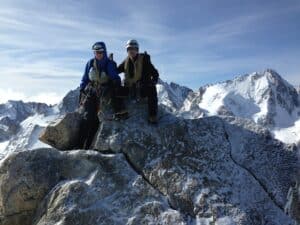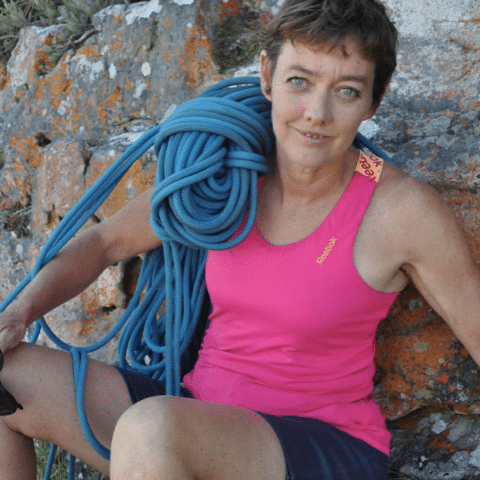The Effecient Team: Clifftops and Rainforests – Rachel Colenso
Rachel Kelsey Colenso is an outstanding conference and motivational speaker with a wealth of adventurous experiences that she links seamlessly into a business context and everyday life situations.
Rachel is one of the most extraordinary female adventurers in the world and was a ‘Super Human’ finalist in the UK Channel 4 television series.
Rachel spent a lifetime meeting deadlines in inhospitable and dangerous environments, and has shared her ‘Top Tips’ for when life feels like you cant escape!
Whilst conceptually bizarre, a cliff face is a great place to study efficient teamwork. Your team are literally tied together and cannot escape until the job is done! Every step, every action, affects the entire team whether they like it or not.
Mountaineering efficiency has more to it than avoiding treading on toes, or not bumping someone annoying off your ledge. Other than an element of patience, great mountain teams unite the core requirements of knowledge; skill; and experience, at speed, to reach their goal. The longer they are tied together, the greater that need becomes! The longer they are out there, the greater the exposure to the elements (and to each other), and the more they need to work in harmony. If you take too long, the initial goal or summit is replaced by the need to survive.
Take it from someone who has spent a lifetime meeting deadlines in inhospitable and dangerous environments – from being strapped together on sweltering desert rockfaces; to abseiling through electric storms or rescuing an injured caver in narrow ‘squeeze’ tunnels 240 ft underground. You can learn to work in almost anyone’s company, if the need arises.

Whilst conceptually bizarre, a cliff face is a great place to study efficient teamwork. Your team are literally tied together and cannot escape until the job is done! Every step, every action, affects the entire team whether they like it or not.
Mountaineering efficiency has more to it than avoiding treading on toes, or not bumping someone annoying off your ledge. Other than an element of patience, great mountain teams unite the core requirements of knowledge; skill; and experience, at speed, to reach their goal. The longer they are tied together, the greater that need becomes! The longer they are out there, the greater the exposure to the elements (and to each other), and the more they need to work in harmony. If you take too long, the initial goal or summit is replaced by the need to survive.
When life gets a bit hot under the collar, and you can’t imagine escaping your jungle, try these simple ‘Top Tips.’ – Some are from business psychologist, Robert Kovach, who generously sponsored my team of female explorers before we set off on a groundbreaking trail in 2006, discovering a partially unchartered section of the Amazon rainforest in Guyana. We underwent psychological profiling, teambuilding sessions and support. What we ultimately required saving from was not the man-eating White-lipped Peccary or stealthy jaguar, but each other. It was the most valuable sponsorship I have ever received!
TOP TIPS:
1. Greeting:
Take a few minutes to ‘say hello’ and create an informal opportunity to personally connect with each other. Connecting withing your team whilst uncoiling the ropes will take less time fixing an issue halfway up a cliff. It gives you the opportunity to make adjustments before setting off, and to build a great, positive start.
2. Closing:
Knowing when to stop is vitally important for sustainability. On a mountain, it is unsafe to continue as exhaustion creeps in. Your judgement becomes impaired, and life or death mistakes are easy to make. You need to plan your time to ensure that wherever you stop for the night your team has time for a debrief, personal admin, and to gain enough sustenance and rest to continue. A goal is more likely to be met with a fresh set of minds. Pushing on for extended time is reserved for extreme situations, so you have the capacity to take on a big challenge when needed, and not every day.
3. Planning and Preparation:
Our increased reliance on technology has seen a decrease in advance planning, site specific planning, and a continual shifting of plans and deadlines. Whilst agility is a core need in extreme sports like alpinism, a continually changing scenario and on the hoof changes leaves a team unsettled, confused by the inconsistency, and in more danger. Enthusiasm drops, synergy falls away, and the summit isn’t achieved. By contrast, careful consideration to planning, including studying the alternative options, followed by articulating clear aims and expectations, with a stepped approach to achieving goals, removes uncertainties and allows for the team to grow in confidence and ability.
4. Speed:
By creating team-rhythm and working quickly you are able to cover more ground, and still feel refreshed, even energised. This goes back to harnessing your teams’ knowledge, skill and experience. Winning teams thrive on this.
A happy team is a great team to work with!
In October 2003 Rachel Kelsey Colenso hit world headlines when she was stranded on a sheer face at 3000m during an extreme blizzard in the Swiss Alps. After two nights on a tiny ledge with 1000 metre drops each side she was evacuated by helicopter. Her inspiring book, ‘In a High and Desperate Place’ also provides useful information for business or life on how to survive and succeed in times of extreme adversity.
Showreel

Contact us
Call us on 020 7993 2724 or click below to enquire and will will be back to you as soon as possible.
Past Blog Posts







